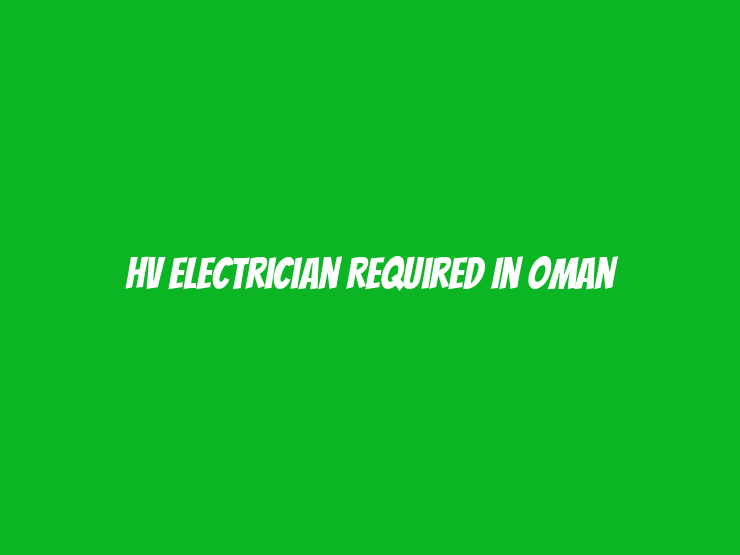An HV Electrician (High Voltage Electrician) is a specialized technician responsible for installing, maintaining, troubleshooting, and repairing high voltage electrical systems and equipment. This includes working with electrical circuits, transformers, switchgear, and distribution networks that operate at voltages typically above 1,000 volts. HV Electricians ensure the reliable delivery of electrical power to industrial, commercial, and utility facilities. They must have an in-depth understanding of electrical systems, strong technical skills, and a commitment to safety due to the high-risk nature of the job. The ideal candidate should be certified in high voltage work, possess extensive hands-on experience, and be knowledgeable about industry standards and regulations.
| Salary | Market Competitive |
| Experience | 8 – 10 years |
| Location | Oman |
| Qualification | Any Graduation |
| Posted | 8 November 2024 |
| Job Type | Full-Time |
| Posted by | Habeebi Recruiter |
| last date to apply | apply within 15 days of posting |
Key Responsibilities
1. Installation and Commissioning of High Voltage Equipment
The HV Electrician is responsible for the installation and commissioning of high voltage equipment such as transformers, circuit breakers, and switchgear. This involves reading and interpreting electrical blueprints, diagrams, and technical manuals to ensure the proper setup of equipment. The electrician must adhere to installation standards, ensuring that all connections are secure, grounded, and meet regulatory requirements. During commissioning, the HV Electrician performs a series of tests to verify that the equipment functions correctly and is ready for operational use.
2. Preventive Maintenance and Inspections
Regular maintenance and inspections are critical to the safe operation of high voltage electrical systems. The HV Electrician conducts routine checks on transformers, cables, substations, and other high voltage components to identify potential issues before they lead to failures. This includes inspecting insulation, checking connections, measuring voltage and current levels, and testing protective relays. Preventive maintenance helps prolong the lifespan of equipment, enhances system reliability, and minimizes the risk of costly downtime or accidents.
3. Troubleshooting and Fault Diagnosis
When high voltage equipment malfunctions, the HV Electrician is responsible for diagnosing and resolving the issue quickly and effectively. This involves using specialized tools such as multimeters, insulation resistance testers, and thermal imaging cameras to pinpoint faults in the system. The electrician must analyze the test results, identify defective components, and implement repairs or replacements as needed. Troubleshooting requires a deep understanding of electrical systems and the ability to work under pressure, especially during emergency situations.
4. Repair and Replacement of High Voltage Components
The HV Electrician performs repairs and replacements on high voltage equipment to ensure the system operates safely and efficiently. This may involve replacing damaged cables, repairing circuit breakers, or upgrading outdated components. The electrician must follow strict safety protocols and use appropriate tools and personal protective equipment (PPE) when working on high voltage systems. Precise and careful handling of repairs is essential to prevent equipment damage, electrical hazards, and power outages.
5. Safety Compliance and Risk Management
Working with high voltage systems poses significant safety risks, and the HV Electrician must prioritize safety at all times. This includes following industry safety standards, such as those outlined by the National Electrical Code (NEC) or the Occupational Safety and Health Administration (OSHA). The electrician conducts safety checks, uses lockout/tagout procedures, and ensures that all team members wear appropriate PPE. Additionally, the HV Electrician must be able to identify potential electrical hazards and take proactive measures to mitigate risks. By maintaining a strong focus on safety, the electrician helps prevent accidents and injuries.
6. Testing and Quality Assurance
The HV Electrician is responsible for performing a series of tests to verify the performance and safety of high voltage equipment. This includes conducting insulation resistance tests, high potential (Hi-Pot) tests, and ground fault tests. The electrician must document the test results and compare them with industry standards or manufacturer specifications to ensure the equipment meets the required criteria. Quality assurance testing helps detect any weaknesses in the system and ensures that high voltage components are ready for operational use.
7. Documentation and Reporting
Accurate documentation is a key responsibility of the HV Electrician. The electrician must keep detailed records of maintenance activities, repairs, inspections, and test results. This information is essential for tracking the condition of high voltage equipment, planning future maintenance, and complying with regulatory requirements. The HV Electrician also prepares reports for management, providing insights into system performance, issues identified, and corrective actions taken.
Conclusion
The role of an HV Electrician is vital for the safe and reliable operation of high voltage electrical systems in industrial, commercial, and utility settings. Through expertise in installation, maintenance, troubleshooting, and safety compliance, the HV Electrician ensures that power systems function efficiently and meet the needs of the facility. This position is ideal for experienced electricians who possess specialized high voltage training, strong technical skills, and a commitment to working safely in challenging environments.
How to apply:
Send your updated resume to our email or directly reach us at our phone:
Email: oman@groupteampro.com
Phone: +96 8240 332 82

